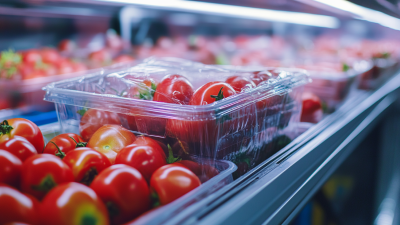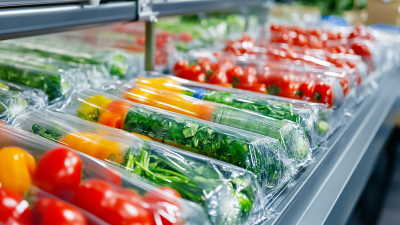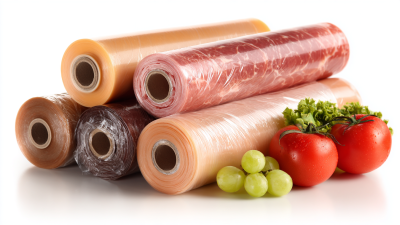Innovative Trends in Food Packaging Roll Plastic Film Driving Sustainability and Reducing Waste
As sustainability becomes a paramount concern in the packaging industry, innovative trends in Food Packaging Roll Plastic Film are leading the charge toward reducing waste and enhancing environmental responsibility. Renowned expert Dr. Jane Smith, a pioneer in sustainable packaging solutions, emphasizes the role of advancements in this field. She states, "The evolution of Food Packaging Roll Plastic Film is not just about functionality; it is a crucial step towards a more sustainable future by minimizing excess waste and promoting recyclability."

The integration of eco-friendly materials and design principles in Food Packaging Roll Plastic Film is revolutionizing how products are packaged and distributed. As industries across the globe seek to align with stringent environmental regulations and consumer preferences for sustainable products, the development of innovative packaging solutions is critical. Through advancements in biodegradable plastics and smart packaging technologies, the sector is embracing a new era that not only preserves the quality of food but also honors the planet.
Moreover, this shift towards sustainable practices in Food Packaging Roll Plastic Film is inspiring brands to rethink their packaging strategies. By adopting innovative materials and methods, companies can significantly reduce their environmental footprints, appealing to conscious consumers and setting new industry standards. As we delve into the innovative trends and their implications, it is clear that the future of food packaging is both exciting and necessary for achieving a sustainable world.
Understanding the Role of Plastic Film in Sustainable Food Packaging Solutions
The role of plastic film in sustainable food packaging solutions has gained significant traction in recent years, driven by innovations that enhance sustainability and address the pressing issue of waste. The global food packaging films market is projected to expand from USD 59.6 billion in 2025 to USD 106.6 billion by 2035, with a compound annual growth rate (CAGR) of 6.0%. This growth underscores the increasing demand for sustainable packaging options that not only preserve food freshness but also minimize environmental impact.
Recent developments, such as the creation of compostable plastic films made from food waste sugars, highlight the potential of bioplastic solutions. Researchers have pioneered methods to convert food waste into natural plastic films, demonstrating a practical application of waste materials in creating eco-friendly packaging. Additionally, advancements in xanthan gum-based films present another promising avenue, reinforcing the versatility and adaptability of sustainable packaging materials. As recyclable film technologies evolve and collaborations emerge in the industry, the future looks brighter for innovative food packaging that prioritizes both performance and environmental stewardship.
Exploring Innovative Materials for Eco-Friendly Roll Plastic Film
The demand for eco-friendly roll plastic films is rapidly increasing as industries seek sustainable packaging solutions. Innovative materials are at the forefront of this change, focusing on reducing environmental impact while maintaining functionality. Bioplastics, derived from renewable resources like cornstarch and sugarcane, are gaining popularity as they not only decompose naturally but also offer comparable strength and barrier properties to traditional plastics. Moreover, advancements in polyhydroxyalkanoates (PHA) are creating opportunities for fully biodegradable films that can replace conventional plastic without compromising performance.
In addition to bioplastics, there are ongoing explorations into recycled materials for roll plastic films. Companies are increasingly utilizing post-consumer waste to create new film products, reducing the reliance on virgin materials and minimizing landfills. Innovations such as upcycled film technologies are enabling the production of high-quality packaging from recycled content, fostering a circular economy within the packaging sector. These developments not only address plastic waste issues but also appeal to environmentally-conscious consumers, making sustainable packaging an attractive choice for brands looking to enhance their green credentials.
Innovative Trends in Food Packaging Roll Plastic Film
Implementing Efficient Waste Reduction Strategies in Food Packaging
The food packaging industry is undergoing a significant transformation as companies increasingly adopt efficient waste reduction strategies. According to a report by the Food Packaging Institute, approximately one-third of food produced globally is lost or wasted due to inadequate packaging solutions. By implementing innovative roll plastic films, manufacturers can minimize excess material usage while ensuring food safety and longevity. These advancements not only contribute to a decrease in food waste but also reduce the environmental impact associated with packaging materials.
Sustainable packaging solutions, including biodegradable and recyclable roll films, have emerged in response to growing consumer demand for eco-friendly practices. A study from the Global Packaging Alliance indicates that 74% of consumers are willing to pay more for sustainable packaging options. Companies are leveraging this trend by optimizing their packaging designs, leading to a 20% reduction in plastic usage without compromising quality. Efficient waste reduction strategies not only enhance the sustainability profile of food packaging but also increase operational efficiency, directly benefiting both the environment and the bottom line.
Innovative Trends in Food Packaging Roll Plastic Film Driving Sustainability and Reducing Waste
| Material Type | Sustainable Feature | Waste Reduction (%) | Recyclability (%) | Market Growth (2023) |
|---|---|---|---|---|
| Biodegradable Film | Compostable | 30 | 90 | 15% |
| Recycled PET Film | Made from Recycled Materials | 25 | 100 | 12% |
| Plant-Based Plastic | Sustainable Sourcing | 20 | 85 | 10% |
| Bio-based Polyethylene | Carbon Footprint Reduction | 15 | 70 | 8% |
| Multi-layer Films | Improved Shelf Life | 10 | 60 | 5% |
Designing Packaging for Enhanced Shelf Life and Reduced Environmental Impact
Innovative packaging designs focusing on sustainability are becoming essential in the food industry, particularly as environmental concerns grow. The current trends emphasize enhancing the shelf life of products while reducing their environmental impact. With the global shift towards biodegradable and eco-friendly materials, the food packaging sector is projected to evolve rapidly, aligning with consumer demand for climate-friendly solutions. The use of innovative roll plastic films not only preserves food freshness but also minimizes plastic waste, contributing to a healthier planet.
In addition, the rising value of industries like the biopackaging sector, which is expected to reach substantial milestones by the early 2030s, underscores the urgency for sustainable practices in packaging design. This growth trajectory indicates that brands are increasingly investing in advanced materials that are both functional and environmentally responsible. By prioritizing these innovative trends, companies can not only meet regulatory requirements but also enhance brand loyalty among eco-conscious consumers who favor products that reflect their environmental values.
Adopting Circular Economy Principles in the Food Packaging Industry
The adoption of circular economy principles in the food packaging industry is a pivotal shift towards sustaining our environment. Instead of the traditional linear model where materials are used and discarded, the circular economy emphasizes reusing, recycling, and regenerating products. In this context, innovative trends in food packaging, such as biodegradable and compostable films, are transforming how food products are packaged. These advancements not only minimize waste but also foster a sustainable lifecycle for materials, ensuring that they are effectively utilized and not left to harm our ecosystems.
Furthermore, this circular model encourages collaboration among stakeholders, from manufacturers to consumers, to rethink product design and consumption patterns. By prioritizing the use of renewable resources and enhancing recycling processes, companies can significantly reduce their carbon footprint and plastic pollution. As the food packaging industry embraces these sustainable practices, it not only meets consumer demand for eco-friendly options but also demonstrates corporate responsibility, paving the way for a greener future.
Related Posts
-

Maximizing Freshness and Safety with Innovative Plastic Roll for Food Packaging Solutions
-

Innovative Trends in Food Packaging Plastic Roll Market Driving Sustainability and Efficiency
-

Emerging Technologies in Food Packaging for 2025 with Best Plastic Film Rolls
-

Global Trends in Food Packaging: 2025 Market Insights & Case Studies on Best Food Packaging Roll Plastic Film
-

Exploring Innovative Alternatives to Traditional Food Packaging Bags
-

How to Choose the Right Plastic Film Roll for Food Packaging Based on Industry Standards

 中国
中国